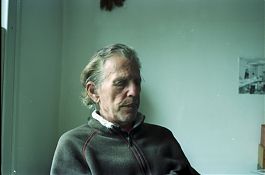LIKE MANY PEOPLE, we came to know Seth Siegelaub through his curatorial work in the 1960s with artists Carl Andre, Robert Barry, Lawrence Weiner, Sol LeWitt, and Joseph Kosuth, among others. However, his contributions to the art world have a wider impact than a single generation of artists.
While the era of the late ’60s represents only a small fraction of Siegelaub’s polymathic life, we were drawn to his work in this period because of his innovative use of the catalogue as the sole framework for an exhibition. That is to say not a catalogue for an exhibition, an ancillary publication tied to the presentation of work in a physical space, but rather the catalogue as the exhibition in and of itself, one that could be distributed beyond cultural centers and sold cheaply. These were exhibitions that found their way out into the world; they didn’t just wait around for the world to find its way to the gallery. In this approach one can see Siegelaub’s early attempts at not only dematerializing the art object but also democratizing the art world, a mission he returned to throughout his life.
Siegelaub’s focus on the publication as an exhibition space dovetailed nicely with others who, following the paperback revolution, looked toward the book as a new or alternative venue for the exhibition of works of art. Siegelaub, along with Dick Higgins and Something Else Press, George Maciunas, Ed Ruscha, Hansjorg Mayer (to name just a few) helped to give rise to the medium of artists’ book as we know and celebrate it today.
When we sat down to determine a name for a new organization devoted to publishing artists’ books, we decided on Primary Information after Siegelaub’s use of the term (in reference to the shift from the book role as primary information rather than secondary information). In 2008, shortly after the organization was minted and our first few publications were in the world, we reached out to him to ask if we could reprint his “The Artist’s Reserved Rights Transfer and Sales Agreement” online in preparation for Primary Information’s participation in “That was then . . . this is now” at MoMA PS1.
Siegelaub readily agreed and we began a larger conversation about the role of the online publication. Siegelaub was frequently invited to revisit his projects from the ’60s and ’70s, but was uninterested in memorializing his past accomplishments. Many publishers (including Primary Information) requested permission to reprint his books in physical form, but he said no, recognizing that the format of those projects didn’t fit the time. He told us quite frankly that he didn’t believe in books anymore, and he regularly chided us for putting too much emphasis on the paper-bound book, that is to say for engaging in old-fashioned publishing.
There was a great deal of interest in our publication of Artist’s Reserved Rights, and Siegelaub saw there was an online audience that wanted to understand his projects. Unrestricted access to his books was in line with his desire to reconcile his political interests with his involvement with art. In the fall of 2008, he gave us a matching grant devoted to publishing works online, including many of those now classic titles of his from the late ’60s. This grant came through the Stichting Egress Foundation, which he founded to centralize his diverse interests in art, politics, textiles, and physics. In its final years, the foundation began funding projects in these areas.
The statement on his website gives insight into his warm approach:
We are pleased to consider requests and applications for grants from people and groups involved with critical research projects in our three areas of interest, especially “unprofitable” projects centered on archives, documentation, bibliographic, and “open access” online database issues. In general we prefer slow, patient, ongoing, critical but quiet projects as opposed to noisy ones. Normally we only offer matching grants. Note we do not provide grants for art exhibitions or artist’s projects.
Concerned about the limitations of possessing his own collection of art and textiles, he created a resource for younger people interested in a complete history or his diverse interests. Siegelaub considered archiving to be one of the most radical activities that he could contribute to a changed art world, and he saw the Internet as a way to democratize and disseminate these archives, much like his approach to books.
In addition to the previously mentioned financial support, he also gave us practical advice that we will always hold dear—never hold a meeting over brunch (because your eggs will get cold while talking) and don’t spend too much time on books and work. He insisted that we use part of the money from his small grant to have a nice dinner and a relaxing night out. In a community that now encourages art workers to work constantly and always with a professionalism very different than his time of protest, this stipulation came as quite a shock. Perhaps what stays with us more than anything was the spirit with which Siegelaub carried out his work and lived his life—though he worked tirelessly and made a big impression on the subjects and fields he delved into, it’s hard to imagine him without a smile on his face.
Primary Information was formed in New York in 2006 by James Hoff and Miriam Katzeff.
Carl Andre, Dan Graham, and Liz Kotz’s reflections on Siegelaub appear in the December 2013 issue of Artforum.
